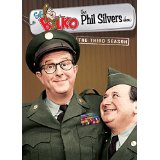Phil Silvers was aptly named. If anyone in show business had a silver tongue, it was Phil. He started, like most comedians of the era, in Burlesque and Vaudeville. There he honed the natural talent that would make him one of the first true television stars in the industry. With The Phil Silvers Show he introduced us to the character of Sergeant Bilko. From 1955 to 1959 Silvers and his Bilko character would take the television landscape by storm. In 1956 the show became the very first series in television history to win three Emmy Awards in a single year. That year the wins came in the Best Comedy Series, Best Actor (Silvers) and Best Director. The last honor went to the show’s creator, Nat Hiken.
The Phil Silvers Show would also become one of syndicated television’s first mainstays. In syndication it was called Sergeant Bilko. It didn’t matter if the show was named after Silvers or Bilko, for they were truly one and the same. Silvers brought his own strong stage presence to the character of Bilko. He was a sergeant in the Army. He was stationed at the fictional Fort Baxter in the fictional town of Rosewood, Kansas. He ran the platoon who worked the motor pool. Suffice it to say that there was little motor pool work being done, and it’s a miracle any of the vehicles still ran by the time the show reached its fourth and final season. For you see, Bilko was more interested in his latest money-making scheme than performing his Army duties. And even though he usually touched each and every man in his unit for their last cent, they loved their sergeant. He would have their backs, particularly if there was a percentage to be made in the process.
Bilko’s first partner in his cons was Henshaw, who was played by Allan Melvin. Melvin would go on to play Sam the butcher on The Brady Bunch and Barney Heffner on All And The Family and Archie Bunker’s Place. Bilko’s second henchman was Rocko Barbella (sound familiar?). Rocko was played by Harvey Lembeck. Together they ran the platoon’s Welfare Fund that was intended to be there when the guys needed some extra money. Of course, it always ended up financing a Bilko scheme or vacation. The platoon was filled with colorful pigeons for Bilko to fleece. There was the lovable Doberman, played by Maurice Gosfield. Doberman was the chubby, naive member of the unit as well as the most lovable of the characters. You might remember Gosfield as the voice of Benny in the Top Cat cartoons. Ritzik was one of Bilko’s steady poker players and a man he could always beat. He was played by Joe E. Ross who was best known for Car 54 Where Are You. He was famous for his trademark OOOH OOOH expression. Ritzik was the company chef and also incredibly superstitious. That was always a nice in for Bilko when it came to his schemes. Bilko’s foil was the base commander Col. John T. Hall, played by Paul Ford. He was always one step behind Bilko, and it caused him endless heartache. The relationship was very much akin to Yogi Bear and the park ranger. Deep down Hall had a certain respect for Bilko, but it was his job to stop his antics.
Phil Silvers was very kind to new actors, and many would find their first television gig on the show. Dick Van Dyke appeared on the show twice this season and openly credits the show for getting him noticed. He was always grateful to Silvers and met his future The Dick Van Dyke Show production heads on this series. Allan Alda also got his first television appearance in this season. He’s almost unrecognizable as a teen artist who spurns his father’s corporate world. Of course, Bilko sees promise in the art and immediately steps in to represent him, as Bilko did for anyone who displayed a marketable skill or procession.
Bilko was very much a reflection of Phil Silvers. Silvers was a self-professed gambler, as was Bilko. It once even saved his life. Bilko was supposed to share a car ride with his buddy Bugsy Siegel, but Bugsy couldn’t drag him away from the tables. That happened to be the night that an attempted hit on the mobster resulted in his car getting riddled with holes. Silvers would declare that he would have been killed if not for his gambling.
There was an attempt to revive the show in 1963. The character’s name and position were changed. This time Silvers was Harry Grafton, who worked in a factory where he pulled pretty much the same stunts he pulled as Bilko. The New Phil Silvers Show lasted only a season.
Silvers’ trademarks were his iconic glasses and used-car-salesman voice. He could charm the fur off of a bear. It was said that you could get fan mail to his home simply by drawing the glasses on the envelope. Both are prominent features of the show. You get all 35 episodes on five discs. There are also two features, both about a half hour. The first is an interview with two of his daughters Nancey and Tracey.(He had a thing for extra e’s). The second is a 1980 interview on The Paul Ryan Show (not that Paul Ryan). It’s the episodes that take center stage here. It’s a collection of laughs that hold up through the test of time. With one more season left, there’s only one question remaining. “What time is the next bus?”



